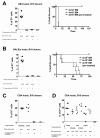Co-receptor and co-stimulation blockade for mixed chimerism and tolerance without myelosuppressive conditioning
- PMID: 16638128
- PMCID: PMC1463008
- DOI: 10.1186/1471-2172-7-9
Co-receptor and co-stimulation blockade for mixed chimerism and tolerance without myelosuppressive conditioning
Abstract
Background: A major challenge in the application of marrow transplantation as a route to immunological tolerance of a transplanted organ is to achieve hematopoietic stem cell (HSC) engraftment with minimal myelosuppressive treatments.
Results: We here describe a combined antibody protocol which can achieve long-term engraftment with clinically relevant doses of MHC-mismatched bone marrow, without the need for myelosuppressive drugs. Although not universally applicable in all strains, we achieved reliable engraftment in permissive strains with a two-stage strategy: involving first, treatment with anti-CD8 and anti-CD4 in advance of transplantation; and second, treatment with antibodies targeting CD4, CD8 and CD40L (CD154) at the time of marrow transplantation. Long-term mixed chimerism through co-receptor and co-stimulation blockade facilitated tolerance to donor-type skin grafts, without any evidence of donor-antigen driven regulatory T cells.
Conclusion: We conclude that antibodies targeting co-receptor and co-stimulatory molecules synergise to enable mixed hematopoietic chimerism and central tolerance, showing that neither cytoreductive conditioning nor 'megadoses' of donor bone marrow are required for donor HSC to engraft in permissive strains.
Figures




Similar articles
-
CD4 T cell-mediated alloresistance to fully MHC-mismatched allogeneic bone marrow engraftment is dependent on CD40-CD40 ligand interactions, and lasting T cell tolerance is induced by bone marrow transplantation with initial blockade of this pathway.J Immunol. 2001 Mar 1;166(5):2970-81. doi: 10.4049/jimmunol.166.5.2970. J Immunol. 2001. PMID: 11207246
-
Apoptotic donor leukocytes limit mixed-chimerism induced by CD40-CD154 blockade in allogeneic bone marrow transplantation.Biol Blood Marrow Transplant. 2006 Dec;12(12):1239-49. doi: 10.1016/j.bbmt.2006.08.038. Biol Blood Marrow Transplant. 2006. PMID: 17162205
-
Combined effects of calcineurin inhibitors or sirolimus with anti-CD40L mAb on alloengraftment under nonmyeloablative conditions.Blood. 2002 Nov 1;100(9):3400-7. doi: 10.1182/blood-2002-03-0872. Blood. 2002. PMID: 12384443
-
Dissociation of hemopoietic chimerism and allograft tolerance after allogeneic bone marrow transplantation.J Immunol. 2001 Sep 15;167(6):3043-8. doi: 10.4049/jimmunol.167.6.3043. J Immunol. 2001. PMID: 11544287
-
Reprogramming the immune system: co-receptor blockade as a paradigm for harnessing tolerance mechanisms.Immunol Rev. 2008 Jun;223:361-70. doi: 10.1111/j.1600-065X.2008.00632.x. Immunol Rev. 2008. PMID: 18613847 Review.
Cited by
-
Murine mobilized peripheral blood stem cells have a lower capacity than bone marrow to induce mixed chimerism and tolerance.Am J Transplant. 2008 Oct;8(10):2025-36. doi: 10.1111/j.1600-6143.2008.02371.x. Am J Transplant. 2008. PMID: 18828766 Free PMC article.
-
Mechanisms of Tolerance Induction by Hematopoietic Chimerism: The Immune Perspective.Stem Cells Transl Med. 2017 Mar;6(3):700-712. doi: 10.1002/sctm.16-0358. Epub 2017 Jan 3. Stem Cells Transl Med. 2017. PMID: 28186688 Free PMC article. Review.
-
Improving the safety of tolerance induction: chimerism and cellular co-treatment strategies applied to vascularized composite allografts.Clin Dev Immunol. 2012;2012:107901. doi: 10.1155/2012/107901. Epub 2012 Oct 22. Clin Dev Immunol. 2012. PMID: 23118778 Free PMC article. Review.
-
Interactions between NKT cells and Tregs are required for tolerance to combined bone marrow and organ transplants.Blood. 2012 Feb 9;119(6):1581-9. doi: 10.1182/blood-2011-08-371948. Epub 2011 Dec 15. Blood. 2012. PMID: 22174155 Free PMC article.
-
Induction of mixed chimerism using combinatory cell-based immune modulation with mesenchymal stem cells and regulatory T cells for solid-organ transplant tolerance.Stem Cells Dev. 2014 Oct 1;23(19):2364-76. doi: 10.1089/scd.2013.0617. Epub 2014 Jun 26. Stem Cells Dev. 2014. PMID: 24804993 Free PMC article.
References
-
- Messner RP. The potential of bone marrow stem cell transplantation in the treatment of autoimmune diseases. J Rheumatol. 1997;24:819–21. - PubMed
Publication types
MeSH terms
Substances
Grants and funding
LinkOut - more resources
Full Text Sources
Other Literature Sources
Research Materials

